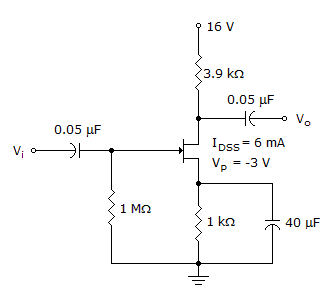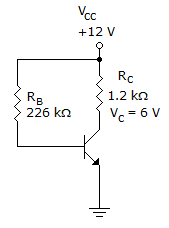Online Electronic Devices Test - Electronic Devices Test - Random
Instruction:
- This is a FREE online test. Beware of scammers who ask for money to attend this test.
- Total number of questions: 20.
- Time allotted: 30 minutes.
- Each question carries 1 mark; there are no negative marks.
- DO NOT refresh the page.
- All the best!
Marks : 2/20
Total number of questions
20
Number of answered questions
0
Number of unanswered questions
20
Test Review : View answers and explanation for this test.
1.
The combination of a short circuit in series with an open circuit always results in a(n) ________ circuit.
Your Answer: Option
(Not Answered)
Correct Answer: Option
Discuss about this problem : Discuss in Forum
Learn more problems on : Diode Applications
2.
Refer to this figure. If an emitter bypass capacitor was installed, what would the new Av be?


Your Answer: Option
(Not Answered)
Correct Answer: Option
Discuss about this problem : Discuss in Forum
Learn more problems on : BJT Amplifiers
3.
The pinch-off voltage continues to drop in a ________ manner as VGS becomes more and more negative.
Your Answer: Option
(Not Answered)
Correct Answer: Option
Discuss about this problem : Discuss in Forum
Learn more problems on : FET Devices
4.
Determine the quiescent values of ID and VGS.

Your Answer: Option
(Not Answered)
Correct Answer: Option
Discuss about this problem : Discuss in Forum
Learn more problems on : DC Biasing-FETs
5.
The range of input impedance Zi for MOSFETs is ________.
Your Answer: Option
(Not Answered)
Correct Answer: Option
Discuss about this problem : Discuss in Forum
Learn more problems on : FET Amplifiers
6.
What is the cutoff frequency of an op-amp if the unity-gain frequency is 1.5 MHz and the open-loop gain is 100,000?
Your Answer: Option
(Not Answered)
Correct Answer: Option
Discuss about this problem : Discuss in Forum
Learn more problems on : Operational Amplifiers
7.
Calculate the output voltage.

Your Answer: Option
(Not Answered)
Correct Answer: Option
Discuss about this problem : Discuss in Forum
Learn more problems on : Op-Amp Applications
8.
How many op-amps are required to implement this equation?
Vo = V1
Your Answer: Option
(Not Answered)
Correct Answer: Option
Discuss about this problem : Discuss in Forum
Learn more problems on : Op-Amp Applications
9.
Which of the following is (are) power amplifiers?
Your Answer: Option
(Not Answered)
Correct Answer: Option
Discuss about this problem : Discuss in Forum
Learn more problems on : Power Amplifiers
10.
Which type of amplifier uses pulse (digital) signals in its operation?
Your Answer: Option
(Not Answered)
Correct Answer: Option
Discuss about this problem : Discuss in Forum
Learn more problems on : Power Amplifiers
11.
Which of the following is (are) the results of improvements built into a comparator IC?
Your Answer: Option
(Not Answered)
Correct Answer: Option
Discuss about this problem : Discuss in Forum
Learn more problems on : Linear-Digital ICs
12.
In a full-wave rectifier, if no load were connected across the capacitor, the output voltage would ideally be a(n) ________.
Your Answer: Option
(Not Answered)
Correct Answer: Option
Discuss about this problem : Discuss in Forum
Learn more problems on : Voltage Regulators
13.
What is the voltage drop across Schottky diodes?
Your Answer: Option
(Not Answered)
Correct Answer: Option
Discuss about this problem : Discuss in Forum
Learn more problems on : Two-Terminal Devices
14.
What is the power density received from the sun at sea level?
Your Answer: Option
(Not Answered)
Correct Answer: Option
Discuss about this problem : Discuss in Forum
Learn more problems on : Two-Terminal Devices
15.
How many terminals does a silicon-controlled switch (SCS) device have?
Your Answer: Option
(Not Answered)
Correct Answer: Option
Discuss about this problem : Discuss in Forum
Learn more problems on : PNPN
16.
Refer to the given figure. The most probable cause of trouble, if any, from these voltage measurements is


Your Answer: Option
(Not Answered)
Correct Answer: Option
Discuss about this problem : Discuss in Forum
Learn more problems on : Transistor Bias Circuits
17.
Refer to this figure. The value of IC is


Your Answer: Option
(Not Answered)
Correct Answer: Option
Discuss about this problem : Discuss in Forum
Learn more problems on : Transistor Bias Circuits
18.
For a JFET, the value of VDS at which ID becomes essentially constant is the
Your Answer: Option
(Not Answered)
Correct Answer: Option
Discuss about this problem : Discuss in Forum
Learn more problems on : Field-Effect Transistors
19.
Refer to figure given below. Determine the value of VGS.

Your Answer: Option
(Not Answered)
Correct Answer: Option
Discuss about this problem : Discuss in Forum
Learn more problems on : Field-Effect Transistors
20.
The output of a Schmitt trigger is a
Your Answer: Option
(Not Answered)
Correct Answer: Option
Discuss about this problem : Discuss in Forum
Learn more problems on : Basic Op-Amp Circuits
*** END OF THE TEST ***
Time Left: 00:29:56
Post your test result / feedback here:
Quick links
Quantitative Aptitude
Verbal (English)
Reasoning
Programming
Interview
Placement Papers
 –10 k
–10 k A.
A.